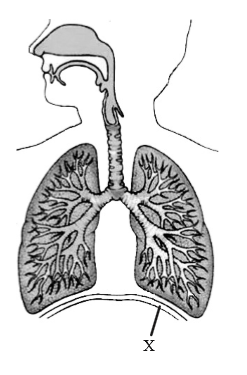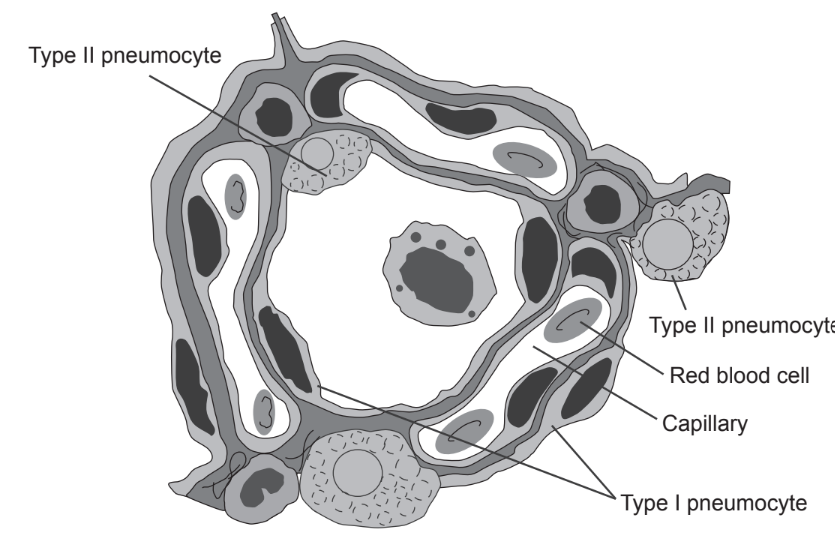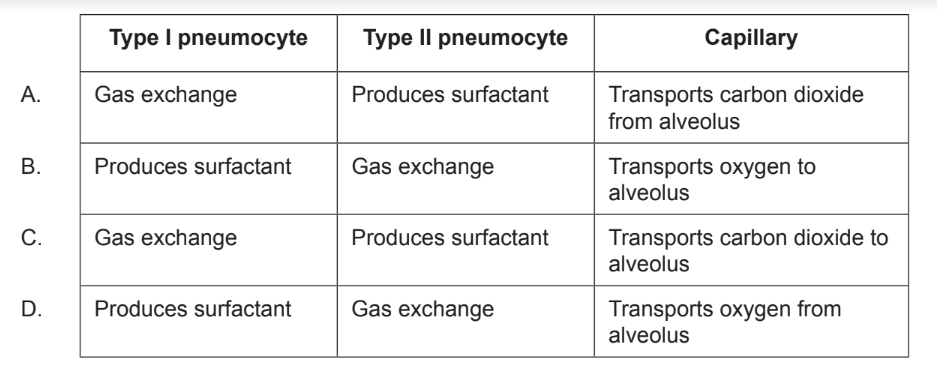IB Biology HL (HIGHER level)- 2024 – Practice Questions- All Topics
Topic 6.4 Gas exchange
Topic 6 Weightage : 20%
All Questions for Topic 6.4 – Ventilation, Lung Structure, Pneumocytes, Mechanism of Breathing, Respiratory Muscles, Lung Disorders, Spirometry, Lung Capacity, Effect of Exercise, More Lung Disorders
Question
Which process results in the exchange of gases across the membrane of pneumocytes?
A Active transport
B Simple diffusion
C Facilitated diffusion
D Mass flow
▶️Answer/Explanation
Ans: B
The process that results in the exchange of gases across the membrane of pneumocytes is B) Simple diffusion. Simple diffusion is the movement of molecules from an area of high concentration to an area of low concentration, and it does not require the input of energy. In the lungs, oxygen moves from the alveoli into the bloodstream by simple diffusion, while carbon dioxide moves from the bloodstream into the alveoli by the same process.
Which type of cell is specialized to facilitate gas exchange?
A. Type I pneumocytes
B. Type II pneumocytes
C. Internal intercostal muscle fibres
D. External intercostal muscle fibres
▶️Answer/Explanation
Markscheme
A
A) Type I pneumocytes are specialized to facilitate gas exchange. These cells are thin and flat, and they make up the majority of the alveolar surface. They are responsible for the diffusion of gases, allowing oxygen to enter the bloodstream and carbon dioxide to exit. Type II pneumocytes, on the other hand, are responsible for the production and secretion of surfactant, which is a substance that reduces surface tension in the alveoli and prevents them from collapsing. Internal and external intercostal muscle fibers are muscles that are involved in the movement of the ribcage during breathing.
What muscle actions cause air to be expelled from the lungs?
A. Internal intercostal muscles relax and diaphragm contracts
B. External intercostal muscles contract and abdominal wall muscles contract
C. External intercostal muscles contract and diaphragm relaxes
D. Internal intercostal muscles contract and abdominal wall muscles contract
▶️Answer/Explanation
Markscheme
D
D) Internal intercostal muscles contract and abdominal wall muscles contract cause air to be expelled from the lungs. During exhalation, the internal intercostal muscles between the ribs contract, pulling the ribs downward and inward and decreasing the size of the thoracic cavity. At the same time, the abdominal muscles contract, pushing the diaphragm upward and further decreasing the size of the thoracic cavity. This increase in pressure causes air to be pushed out of the lungs. The external intercostal muscles are involved in inhalation, not exhalation.
What is a feature of alveoli?
A. They occur in all animals because they are needed for gas exchange.
B. They have a higher oxygen concentration than air in the atmosphere to increase the rate of diffusion.
C. They have walls that are one cell thick for faster diffusion.
D. They are small so keep the gases inside them more concentrated.
▶️Answer/Explanation
Markscheme
C
C) A feature of alveoli is that they have walls that are one cell thick for faster diffusion. This means that the distance over which gases must diffuse between the alveoli and the capillaries is very short, allowing for efficient diffusion of oxygen and carbon dioxide. Alveoli are not present in all animals, as they are a specialized structure found in the respiratory system of mammals. The oxygen concentration in the alveoli is lower than in the atmosphere, as oxygen is constantly being taken up by the bloodstream and replaced with carbon dioxide. Alveoli are small, but this is not to keep gases inside them more concentrated.
The diagram shows the ventilation system in humans.

What is the function of the structure labelled X?
A. Protect the lungs
B. Contract to cause inhalation
C. Become flatter to move the ribcage up
D. Relax in order to increase the thoracic capacity
▶️Answer/Explanation
Markscheme
B
The diaphragm is a large, dome-shaped muscle that separates the chest cavity from the abdominal cavity. During inhalation, the diaphragm contracts and flattens out, increasing the volume of the thoracic cavity and decreasing the pressure inside the lungs. This decrease in pressure causes air to rush into the lungs, filling the expanded space. When the diaphragm relaxes, it returns to its dome shape, decreasing the volume of the thoracic cavity and increasing the pressure inside the lungs. This increase in pressure causes air to be expelled from the lungs during exhalation.
Which muscle action is associated with an increase in the volume of the thoracic cavity when breathing in?
A. The diaphragm contracts.
B. The external intercostal muscles relax.
C. The internal intercostal muscles contract.
D. The abdominal muscles contract.
▶️Answer/Explanation
Markscheme
A
During inhalation, the diaphragm contracts and moves downward, which increases the volume of the thoracic cavity. This creates a negative pressure gradient that causes air to flow into the lungs, filling them with oxygen. The diaphragm is a large, dome-shaped muscle that separates the thoracic cavity from the abdominal cavity. When it contracts, the diaphragm flattens and moves downward, which increases the volume of the thoracic cavity and creates a vacuum that pulls air into the lungs.
Question
The diagram shows a section through an alveolus.

What are the functions of the following labelled structures?

▶️Answer/Explanation
Ans:C
Type 1 pneumocytes are thin flattened cells that are responsible for the gas exchange between alveoli and capillaries. Type 2 pneumocytes are smaller cells that are cuboidal in shape. They are responsible for the secretion of pulmonary surfactants in order to reduce the surface tension in the alveoli. There are many capillaries around every alveoli. This good blood flow maintains a steep concentration gradient between the oxygen and carbon dioxide in the alveoli and the blood so that the rate of diffusion is faster.